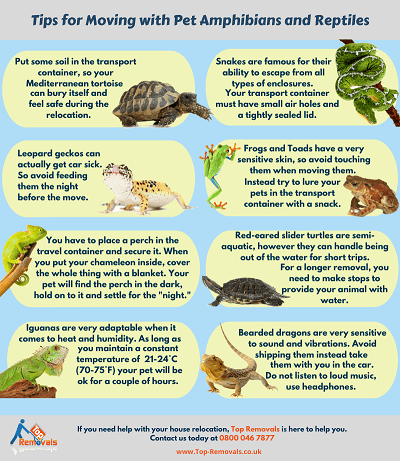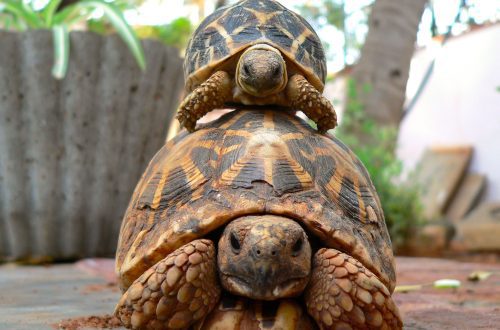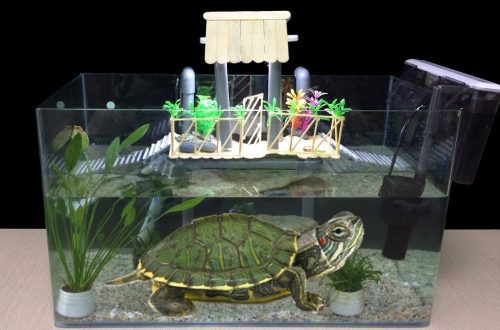
Basic safety when working with a terrarium and terrarium animals
It would seem that in such a safe place as your home, keeping a turtle in a terrarium or other structure suitable for replacing it, unforeseen situations cannot threaten your pet. However, burns, animal injuries during cleaning, or even just stress in reptiles are not ruled out. What you should do first:
- During any manipulations inside the terrarium, whether it is the installation of equipment, the replacement of a lamp or partial cleaning of the soil, all containing animals must be removed, because. due to the insufficient volume of your turtle’s “apartments” for the swing of your person’s arms, it happens that something falls over onto the turtle or the animal is simply scared.
- Constantly monitor the temperature under the lamp, check the distance and angle of the lamp, especially if it is attached movably, for example, in a clothespin lamp. Wet cleaning should be carried out only when the electrical equipment is turned off. Periodically check extension cords, timers, socket connections.
- All electrical cables inside and outside the terrarium must be well insulated and in good condition.
- Always make sure that the animal is not too close to the equipment during the forced movement of the animal inside the terrarium with the lights on, to avoid eye injury and burns.
- You must foresee in advance that from the scenery, if it falls, it can injure an animal or equipment. When decorating a terrarium, if possible, use special terrarium soils, thermometers, backgrounds, plants, shelters, drinkers. They are non-toxic to animals, quite resistant to various kinds of interest in animals and easy to clean.
- You must consider that your pet can eat decorations and artificial plants, soil, especially fine gravel.
- When cleaning with one hand in a terrarium, never hold the animal in the air with the other. The turtle should see the “ground” closely and be on the surface with all its paws, but it is better to be in a sump, carrying, etc.
- When bathing a turtle, always control the temperature of the water. Do not forget that the temperature of the tap water can change dramatically and in just a few minutes boiling water will flow from the tap. Never leave a turtle in a basin/tub next to running water from a tap.
- Maintenance and uncontrolled free-range on the floor are unacceptable. Injuries with doors, furniture, children, dogs and cats, fungal infections from dust and your microflora, ingestion of foreign objects: hair, thread, paper clips, etc., leads to blockage and injuries to the gastrointestinal tract.
- Never, under any circumstances, place the aquarium under the rays of the sun, aiming at the glass, supposedly to obtain ultraviolet radiation. First, ultraviolet rays do not pass through glass. Secondly, without the ability to thermoregulate, your turtle will not only get heatstroke, but the temperature of its body and blood itself will be exactly what it would be in the sun.
- When walking a turtle in the summer on the balcony, consider all conceivable and unthinkable escape routes. The turtle climbs and digs well, and it will achieve special success the sooner the more free time and thirst for adventure it has. And therefore, all the scenery – in the center of the enclosure. Any hole in the mousehole fence can turn into a great loophole for your turtle in just a few hours. Particularly stubborn turtles can climb up even on absolutely smooth boards and tulle, dig under fences, so consider all the maneuvers of the “scout” and make sure that he has something to do inside. When walking in the summer, it is always necessary to provide a shadow.
- When keeping red-eared turtles, you should take it for granted that this species leads an active lifestyle and loves to drive filters, heaters and each other around the aquarium. Therefore, shock-absorbing mats must be placed under the aquarium, large stones, grottoes, etc., which can be turned over, which can break the glass when they hit the bottom of the aquarium, are not placed in the aquarium.
- Consider the location of the terrarium in your apartment. It is highly not recommended to install a terrarium in the kitchen and in a cramped corridor, near the window, too close to the radiator and windows to avoid drafts.
- Ventilation should always be provided in the terrarium.





